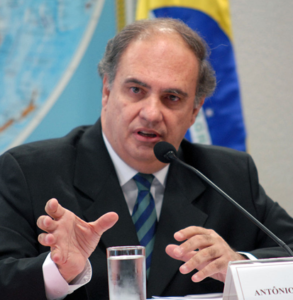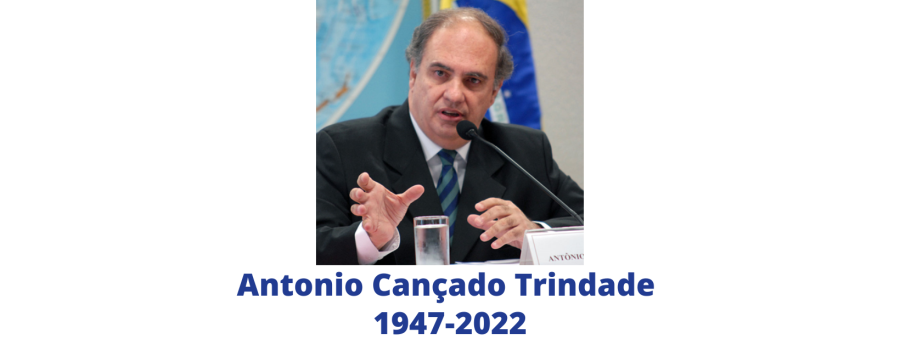Antonio Cançado Trindade (1947-2022): A personal tribute by Christina M. Cerna

I cannot think of any other jurist who was so prepared for his destiny and so riveted to the path of fulfilling it, once he was firmly on the path, as Antonio Cançado Trindade.
Antonio Cançado Trindade was a brilliant Brazilian jurist, who spent 10 years as a judge on the Inter-American Court of Human Rights (1995-2000, 2001-2006) and then 13 years as a judge on the International Court of Justice (2009-2022). He served as President of the Inter-American Court from September-December 1999, and then again 2000-2001 and 2002-2003. His untimely death occurred on May 29, 2022, at the age of 74, during his second term on the International Court of Justice.
Curiously, Antonio Cançado was a contemporary of the other brilliant jurist on the World Court, the Australian, James Crawford, and their lives paralleled in certain respects. Cançado was a year older but they both received their PhDs from Cambridge in 1977. Cançado’s thesis received the Yorke prize (best thesis of the year) and was on “Developments in the Rule of the Exhaustion of Local Remedies in International Law.” Crawford’s thesis was on the creation of states under international law, under Professor Ian Brownlie, published in 1979 by OUP. Crawford served on the International Court of Justice from 6 February 2015- 31 May 2021 and died while on the Court, as did Cançado a year later.
I was fortunate to know Antonio Cançado while he was a judge on the Inter-American Court, and I was a lawyer at the Inter-American Commission on Human Rights. He advocated for the victim’s direct access to the Inter-American Court to claim justice for violations of human rights, following the example provided by the European Court of Human Rights, which in 1998 fused the European Commission and Court to create a sole institution, the European Court of Human Rights, and granted the victim direct access to the European Court. In 2000, I was granted a Fulbright to study in Strasbourg, the seat of the European Court, to study whether the European Court was collapsing under the weight of an avalanche of cases that were no longer filtered by the European Commission or whether the Court was functioning well. It was clear to me after three months in Strasbourg that the European Court was functioning well. But it was no longer the appropriate model for the Inter-American system.
The Inter-American system did not have the same long trajectory of the European system and the fusion of the Inter-American Commission into the Inter-American Court did not have the same urgency as it did in Europe, despite Judge Cançado’s call for the expiration of the Commission and direct access to the Inter-American Court for the victim. The Inter-American Commission and Court have seven members each and were not as duplicative in their decisions as the European Commission and Court that had over 40 members each (one for each State Party to the European Convention on Human Rights).
But Judge Cançado’s call for the autonomy of the victim from the Commission had resonance. With the creation of the Inter-American Court, the victim’s lawyers were considered “assistants” of the Commission rather than “parties” to the case. Eventually the Rules of Court were amended, and the victim’s representatives and the State were officially considered the parties to the case and the Commission’s role became that of a Ministerio Publico, explaining and defending its rationale for bringing the case to the Court. This new realignment of roles was more appropriate and changed the actual litigation. For Judge Cançado, the right to access to justice was a peremptory norm of international law and encompassed access to a tribunal, the right to a fair trial, due process of law, reparations, and the execution of judgments.
The coherence of Judge Cançado’s view of the individual/victim, rather than the State, as the center of international law was something that he had fully formed in his studies and time as a judge in the Inter-American system, this evolved into his concept of the “humanization” of international law. His many concurring, dissenting and separate opinions all further elaborated this human-centered view of international law. Brill publishers recognized how unique he was and in its series on “Judges” included a collection of his individual opinions (1991-2013) entitled: “Judge Antônio A. Cançado Trindade. The Construction of a Humanized International Law.” The volumes included his separate opinions and commentaries during his time on the Inter-American Court and the International Court of Justice. Unfortunately, he was not as widely esteemed on the International Court of Justice as he was on the Inter-American Court, but he carefully constructed his separate or dissenting opinions to leave behind a coherent explanation of his world view and how he differed from his contemporaries. His was a unique talent and commitment to the central role of the individual in international law, perhaps our greatest achievement in the 20th century. He will be greatly missed.
Christina M. Cerna is a Vice-President of the American Branch of the International Law Association.
Deprecated: Method hb_options is deprecated since Highend version 3.7. Use highend_option instead. in /home/abila/public_html/wp-content/themes/HighendWP/functions/deprecated.php on line 611




